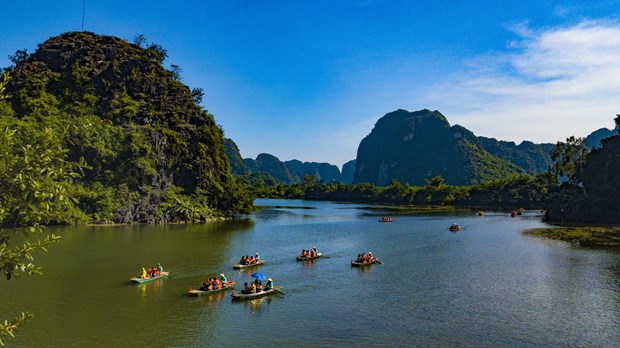As host of the 2021 National Tourism Year, with the theme “Hoa Lu - Thousand-year-old Capital”, the northern province of Ninh Binh will work to promote itself as an attractive and safe destination for tourists.

Trang An in Ninh Binh (Photo: VNA)
If COVID-19 remains under control, the 2021 National Tourism Year will officially get underway on March 20. Otherwise, it is scheduled to begin on April 29.
Major activities will include the Hoa Lu, Trang An, and Dan Kinh Thien festivals, the “Golden colours of Tam Coc - Trang An” tourism week, a painting exhibition entitled “Ninh Binh cultural heritage”, a photo exhibition on “Legendary Ninh Binh”, and the Cuc Phuong forest week.
A range of activities will also take place in 27 cities and provinces nationwide.
Chairwoman of the provincial Tourism Association Duong Thi Thanh said the province will make the best use of digital transformation to advertise the different events.
Located in the southern reaches of the Red River Delta, Ninh Binh is known for its wondrous natural scenery, with a labyrinth of waterways, mountains, and plains as well as cross-cultural influences from the north to the south and from the mountains to the plains and coastal areas.
With unique artistic, geological, geomorphic, and landscape values and traces of pre-historic life, the Trang An Landscape Complex was recognised by UNESCO as a World Cultural and Natural Heritage Site in June 2014, becoming the first mixed natural and cultural property in Vietnam. It is also home to a number of attractions recognised as special national relic sites.
Foreign geologists have lauded Trang An as one of the world’s most beautiful karst tower landscapes, an “outdoor geological museum” over 250 million years old and a primeval forest with rare flora and fauna. Its karst towers, which have been weathered by wind and water, have turned Trang An into what many call “Ha Long Bay on Land”.
The Trang An complex is covered by green forest and bell-shaped karst formations up to 200 metres tall. It is surrounded by rolling mountain ranges and swamps interconnected via an underground stream network.
Lying in the complex, the Trang An eco-tourism site has also been honoured as a special national relic. It boasts 250-million-year-old limestone mountains and winding, meandering swamps, valleys, and caves. There are also flooded forests, forests on limestone mountains, and traces of the ancient capital of Hoa Lu.
Also part of the complex, the Tam Coc - Bich Dong tourism site is about 8 km from the centre of Ninh Binh city, in Ninh Hai commune, Hoa Lu district. Beautiful year round, Tam Coc is at its most impressive in June, when its paddy fields turn golden at harvest time.
Its three caves were formed by the Ngo Dong River flowing through the mountain.

An aerial view of Trang An (Photo: VNA)
Tam Coc was in the top 15 “beautiful but little-known” destinations in 2015, as voted on by readers of the UK’s The Telegraph newspaper.
In early 2018, the image of the Ngo Dong River as a soft strip of silk curving around mountains in Tam Coc appeared in Business Insider magazine, heading a list of the 50 most attractive destinations in the world.
Two thousand-year-old temples dedicated to the Dinh and Le emperors also add to the attractiveness of Hoa Lu. Other pagodas and temples were built within limestone mountains, of which Bai Dinh is one of the largest in Southeast Asia.
Tourist arrivals in Ninh Binh increased 11 percent annually from 2010 to 2019, with revenue growing 23.6 percent.
It welcomed around 7.4 million visitors in 2018, including 6.5 million domestic travellers, and earned over 3.6 trillion VND.
Due to the COVID-19 pandemic last year, arrivals reached just 2.8 million, or 37 percent of the figure in 2019.